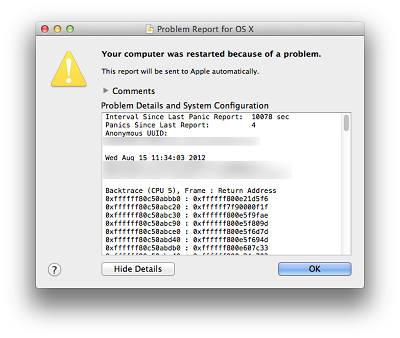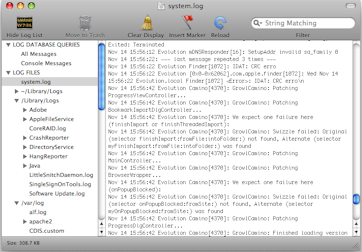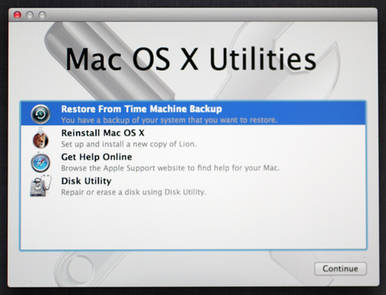Mac OS FAQ |
Updated: 31 December 2023
1. What is a Crash?
A crash occurs when a misbehaving program or driver shutdowns Mac OS completely and displays an error message. On Mac OS this is sometime a panic message. Sometimes the faulty program will just stop responding and either hangs or shuts it self down and display the desktop. Fortunately, Mac OS is very stable, and only the program will crash and not the computer.

2. What is a Hang, freeze or slow system?
Hanging, freezing or unresponsiveness can be caused by a program using too much CPU time (see Activity Manager ) and not allowing Mac OS or other programs to run. Bad hardware or drivers can also cause freezing as the hardware is either incorrectly installed, or the drivers has bugs or some other problem. For more advanced troubleshooting you can download more tools such as the Apple Hardware Test or Apple Diagostic tools.
3. What is a Reboot?
A reboot is when a serious problem occurs and the computer unexpectedly shuts down and restarts. This is usually caused by hardware problems such as overheating CPU or component or not enough power to the system. Poor ventilation, dust build up and other factores can cause over heating. Power spikes and surges can also cause reboots as well, a spike protection device or a UPS (Uninterruptable Power Supply) can fix those problems.
4. How do I troubleshoot crashes, hangs and reboots?
When you can back into your system, load up the Console and check the system and application logs for any recent errors and warnings. These can point you to potential problems on your system. If you have problems with running games or your graphics card or sound card, load Apple Hardware Test to see if there is a problem with any devices on your system. It is always a good idea to send a report to Apple when you get these problems so they can be looked into by Apple Engineers and Support staff.

If using the command line, you can use tools such as more, tail and grep to view and search logs in /var/log, /Library/Logs or ~/Library/Logs folders.
5. How do I restore back to a previous configuration?
You can revert to a previous version of Mac OS using Time Machine to restore to an older version of your system.
Alternatively, you can delete bad preference files for certain settings or programs, by deleting the preference file in /Users/username/Library/Preferences, then set up fresh preferences again within System Preferences or within the Application.
To remove bad extensions or drivers, you can unload it and then delete it from the system. E.g.
sudo kextunload /System/Library/Extensions/KEXT_NAME.kext
sudo rm -r /System/Library/Extensions/KEXT_NAME.kext
6. How do I copy missing files from my Mac OS installation?
Most files for Mac are stored on the Mac OS media or from an installation file. You can use Time Machine to restore missing files or applications, or you can copy it from another Mac with the same version of Mac OS or use a program called Pacifist to restore files.
7. What does the error message mean?
When an application fails, it will display an error message, here are a list of error messages with an explaination.
8. How do I get to the Recovery Console or Terminal?
You can do the following two ways:
a) Press Command+R during bootup of the Mac from the Hard disk.

b) Click on Utilities menu and you get these options:
c) You can access the command line, via Terminal, and run the following fault finding tools:
More commands are listed on the ss64.com site.
9. How do I create a Recovery disk, so I can use it to reinstall Mac OS?
You can no longer create a bootable DVD, but you can create a bootable USB stick. You can create it from the disk image from the Install macOS installation file you downloaded:
a) Locate the Mac OS X Name installation file in the Applications folder. If it is not there, download it again from the App Store.
b) Open the Terminal program and start a shell.
c) Insert a blank USB drive in your Mac (16GB or more).
d) Enter the following command in the Terminal window shell. Replace MacOSName with actual OS name, and untitled with the name of your USB Stick
sudo /Applications/Install\ macOS\ MacOsName.app/Contents/Resources/createinstallmedia --volume /Volumes/Untitled --applicationpath /Applications/Install\ macOS\ Sierra.app --nointeraction
e) Once completed, eject the USB drive and close the Terminal window.
Go to Disks and CD Recording